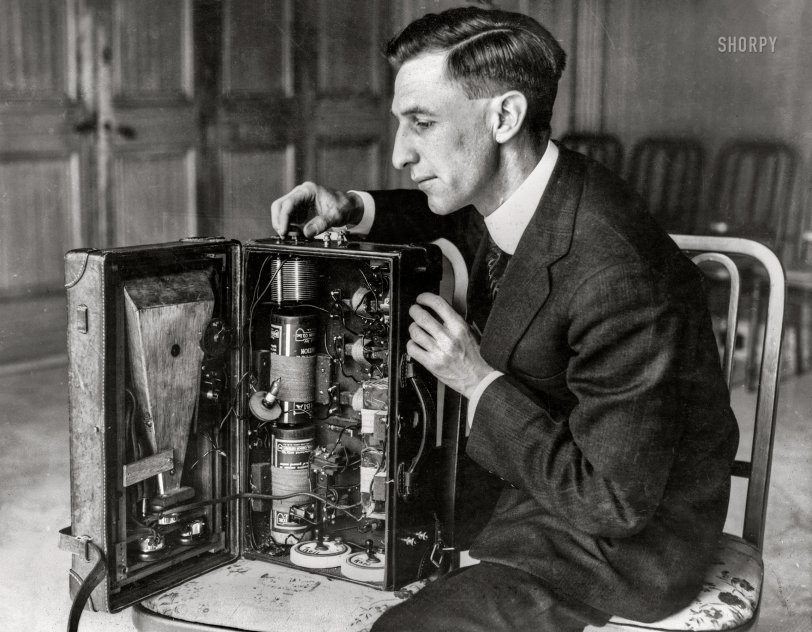


Framed or unframed, desk size to sofa size, printed by us in Arizona and Alabama since 2007. Explore now.
Shorpy is funded by you. Patreon contributors get an ad-free experience.
Learn more.

- Tough Guys
- Lost in Toyland
- And without gloves
- If I were a blindfolded time traveler
- Smoke Consumer Also Cooks
- Oh that stove!
- Possibly still there?
- What?!?
- $100 Reward
- Freeze Frame
- Texas Flyer wanted
- Just a Year Too Soon
- WWII -- Replacing men with women at the railroad crossing.
- Yes, Icing
- You kids drive me nuts!
- NOT An Easy Job
- I wonder
- Just add window boxes
- Icing Platform?
- Indiana Harbor Belt abides
- Freezing haze
- Corrections (for those who care)
- C&NW at Nelson
- Fallen Flags
- A dangerous job made worse
- Water Stop
- Passenger trains have right of way over freights?
- Coal
- Never ceases to amaze me.
- Still chuggin' (in model form)
Print Emporium
The Singing Valise: 1922

April 1922. Chicago. "The Singing Valise -- F.W. Dunmore, of the U.S. Bureau of Standards radio laboratory, with radio built in suitcase." Underwood & Underwood photo. View full size.
CARRIES RECEIVING SET
ABOUT IN SUIT CASE
Government Expert Astounds Gathering of Engineers With Demonstration of Singing Valise -- Explains Small Instrument Capable of Controlling Mechanism at Great Distances
CHICAGO, May 19 -- "The Singing Valise," or "Talks-as-it-walks," may be the latest thing in radiotelephone reception, displayed to the amazement of delegates attending the American Institute of Engineers meeting here last month at the Drake Hotel, by F.W. Dunmore of the radio laboratory of the U.S. Bureau of Standards. Incidentally, it may be pointed out that the engineers at their spring meeting are paying a great deal of attention to radio ...
Mr. Dunmore has a small suit case about one-third the size of an average grip. In the body of the suit case he has batteries, condensers and other paraphernalia of a radiophone receiver. Neatly packed in the cover part is a loud speaker and a loop aerial of tiny wire. The only opening in the sides of the valise is for the mouth of the loud speaker.
While the engineers were gathered in the French Room of the Drake, all windows closed, Mr. Dunmore opened the grip, turned the aerial director toward the Westinghouse broadcasting station KYW, and at once the voice of the announcer of a radio news service was heard.
"That's easy," said Mr. Dunmore, and, closing the satchel, he took hold of the handle and walked about the room. The news bulletins continued to come and were heard in all parts of the room. He walked to every corner of the room and the voice continued until KYW, having completed the news bulletins, signed off.
The reception of radio in a set inclosed in a leather case and all within the confines of the steel, concrete and brick structure of the hotel, amazed even those of the engineers who thought they had seen the very latest in radio reception.
Of greater practical importance, however, was the relay recorder for remote radio control, which Mr. Dunmore displayed and which he described at length in a written report to the engineers.
This instrument, not more than 15 inches square by eight inches deep, contained the mechanism by which ordinary radio telegraph code signals can be strengthened so as to make them operate and control mechanisms at great distances.
By this instrument, also from the radio laboratories of the United States bureau of standards, airships, automobiles, or units of power, electric light, and water plants can be controlled.
A machine equipped with the proper apparatus can be operated by radio through this instrument, said Mr. Dunmore. "We have perfected the instrument to furnish the control. The matter of equipping machinery to respond to this control will be simple."
Still a viable concept
The amplifying horn concept used in this receiver is still employed today in iPhone speakers (probably other brands as well).
Re: Tubes
This is a regenerative receiver, invented by Edwin Armstrong in 1914. Its main advantage is that is only requires one tube (tubes were very expensive). Also, audio amplification is provided mechanically, by the wooden 'horn' shown. Other designs, such as tuned-radio-frequency and super heterodyne receivers, required more tubes, as did electronic amplification of the audio. The disadvantages of this design is that it is very difficult to get tuned correctly, and improper tuning can lead to interference with other radios.
Today, regenerative receivers are still used in things like garage door openers, keyless car entry, and similar things. The man's comments regarding remote control of machinery using the design were right on the mark.
Where are the tubes?
Every radio I have seen from this era usually contained an array of tubes resembling light bulbs. All I see here is a single miniature tube looking like something from the 1950's. There may be other miniatures hidden behind various components, but still. Maybe this thing really was cutting edge.
Progress
Someday they may be able to shrink a Radio down to the size of a Lunch Box!
You'll miss your flight
Just try getting that through a TSA security check.
Demonstration at the Drake
But Mr. Dunmore's haircut, suit and government expense account tell me that he lugged the "portable" radio and radio-control gizmo from some more affordable hostelry down the street.
First Boombox!
Mr. Dunmore needs to perch it on his shoulder.
I had a boombox in high school.
Do kids still have those? LOL
























On Shorpy:
Today’s Top 5